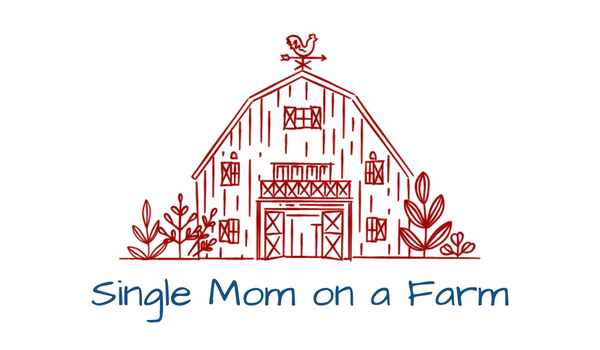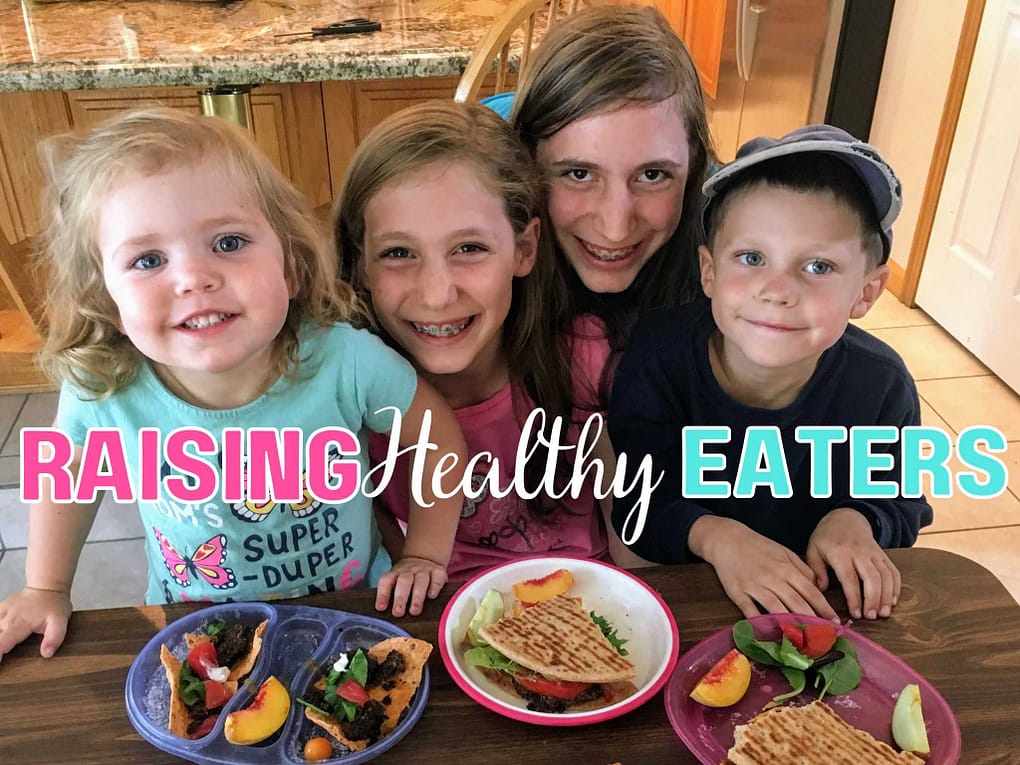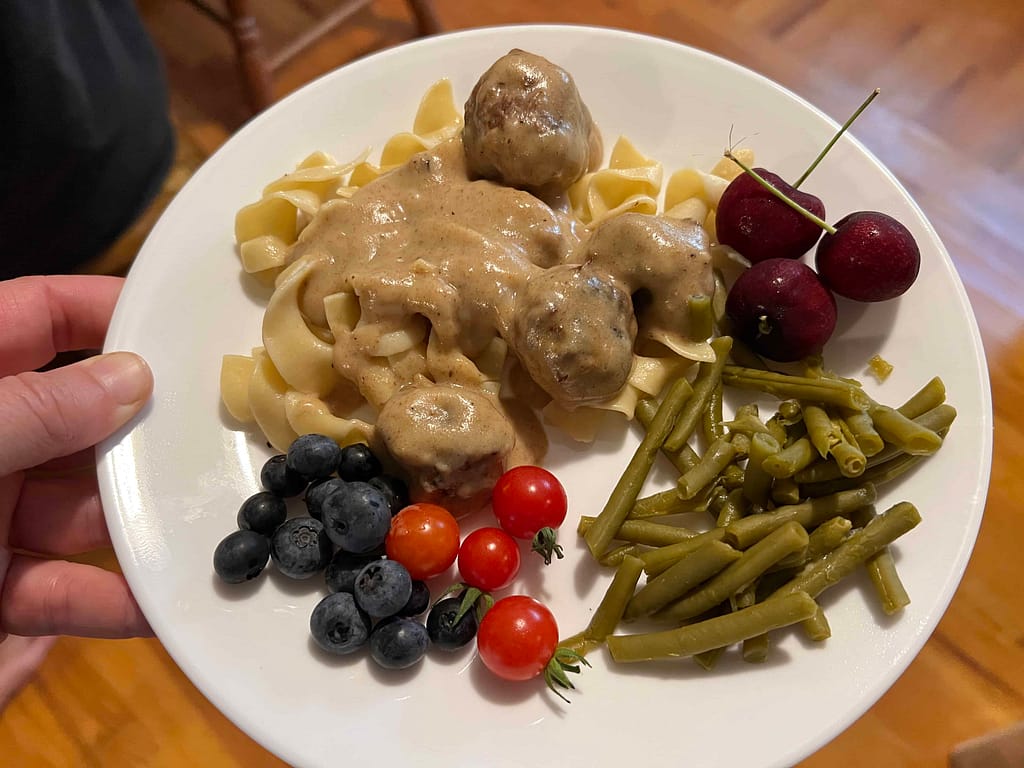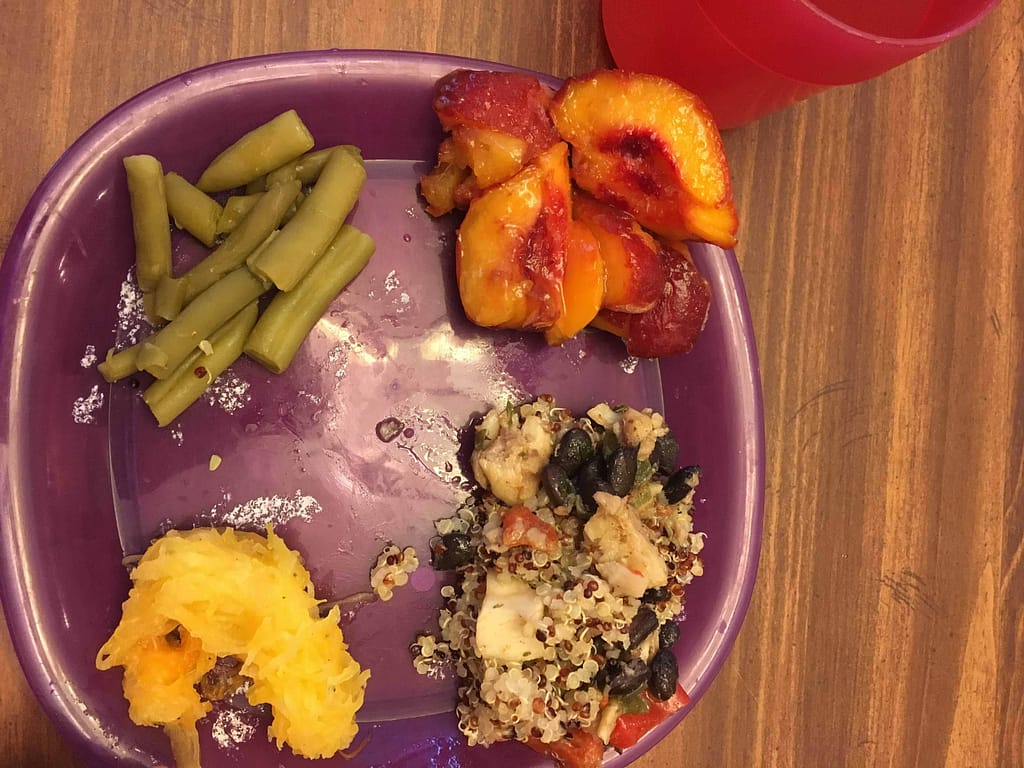Got a picky eater? Worried they’ll be addicted to junk food forever? Wanting to raise healthy eaters? I got you!!
Here are some tips and different options for you as you navigate incorporating more healthy food into your meals and lifestyle. Some are tips to make it easier. Some are options to try depending on if that suits you and your family or not. Pictures of me trying these tips at the end so that the post flows better.
Tip #1 You control what food comes into your house, diaper bag, kids’s lunches, and dinners.
This tip may hurt a bit. It’s one I have to tell myself all the time. I’m wishing my kid would stop eating so many chips and then I realize it’s my own fault because I’m the one who bought them. Sometimes when I look in my cart I see a lot of processed food. But it was on sale or the kids had asked for it. Or it makes for easy meals and I have a busy week. I want to pretend I didn’t see it and just go check out. But I tell myself to go get more fruits, vegetables, and single ingredient foods to at least balance it out.
We homeschool and are home for all 3 meals of the day 7 days a week. If I never bought processed food, they wouldn’t get it. Realizing I have more control over it than I think I do, give me courage that I can help my children eat healthy. I’m just afraid to or don’t want the extra work of making everything we eat from scratch. But I need to admit my own weakness, not blame it on the kids for not choosing healthy food. Do I even have a healthy option for them in my diaperbag?
Tip #2 Go cold turkey
Get rid of all the processed food in your house. Just get rid of it. Go through your cupboards, pantry and fridge and get rid of all the food you don’t want going into your children’s little bodies. Replace it with single ingredient foods (fruits, veggies, nuts, seeds, quinoa, wild rice, etc) or slightly processed food with 5 ingredients or less. Read how Lisa Leake did it in her family’s challenge of 100 Days of Real Food. Reading this book is what converted me to real food and eating healthier.
Tip #3 Gradually add more healthy food to your pantry and fridge.
If you’re not ready to go cold turkey, gradually make the switch. In addition to the normal tortilla chips you buy, start buying organic quinoa chips. Along with the regular cheddar cheese, buy a block of raw cheese. Try the quinoa chips with your regular cheese. Try the raw cheese with the regular chips. Then try the raw cheese on quinoa chips. Talk about what you’re trying in front of your children. Let them try it too. Or just substitute the raw cheese on the regular chips sometime and see if they even notice. Buy more fruits and veggies than you usually do and serve them with your normal meals of frozen pizza or lasagna. (If you’re not ready to start making them from scratch.) Buy yogurts without HFCS or food dyes but instead use organic sugar or honey.
Tip #4 Sneak healthy food into your meals.
Use whole wheat tortillas instead of white. Add beans or quinoa to taco meat. Use grass-fed beef patties and Dave’s Killer buns for hamburgers. Serve Hawaiian haystacks over wild rice instead of white. Use whole wheat flour in the sauce. Put lots of veggies in your soups or stews. (Try our family favorite pumpkin chili!) Grate zucchini and carrots into your meatloaf. Use the leftover healthy meatloaf as the meat in your spaghetti or lasagna. Use whole wheat spaghetti noodles. And also whole wheat elbow noodles when you make macaroni and cheese. Add hemp, flax and chia seeds to all baked goods. There are so many options! And there are lots of cookbooks out there to give you even more ideas. The Sneaky Chef is one of my favorites. She now has several different editions available.
Tip #5 Talk about healthy food.
I’m always talking about what I’ve learned in reading books on healthy food. I mention what diseases they prevent and how I don’t want to get those. I joke about it, “I don’t want you kids making fun of the things I say! I’m eating this kale so hopefully I won’t get dementia.” I also don’t hesitate to say when I don’t like a healthy food but I do appreciate the vitamins it’s giving my body. And that I’m willing to try it a few more times. Sometimes I talk about not liking lettuce as a kid but now it’s one of my favorite foods. Or not ever having seen a green pepper growing up but learned about them from my first college roommate. And now that is one of my favorite foods too. I tell them it’s fine if they don’t like something now. They have their whole life to decide to like it. This puts the pressure off them to have to like to eat healthy. It also doesn’t shut the door on any one food. It lets them think they may like it later.
Talk about the pretty colors and textures on your plate and let your kids take pictures of theirs. My kids are always wanting to take pictures of their plates. They count how many different colors they have. It delays the meal, but is one of the main ways my kids will eat extra veggies. I also talk about feeling good. That I have a lot of energy this morning from my nutritious breakfast.
Talk about where your food comes from. It’s more satisfying knowing where it came from and how it was grown or made, than eating stuff out of boxes with lots of ingredients you can’t pronounce.
Tip #6 Create happy memories around new healthy food.
Have fun conversations at the table. Talk about when they were born (kids love to hear their birth story!) Talk about funny things they said as a toddler. Share how you met their father. Ask everyone what they’d do if they had $1,000. Kids remember more how they felt and the ambiance of a meal more than how it tasted. Make sure they felt heard and loved.
Eat outside as much as possible. Eating outside makes any food taste better! And makes for a fun memory. (If you need an added incentive to eat outside, check out benefits of outside time here.) Go on picnics. Eat on a blanket on the living room floor. Light candles. Eat on your fanciest plates. Decorate paper plates and use those. Anything you can think of to make a great memory! Whatever you do, don’t argue with them about trying new food or being picky eaters. Keep mealtimes pleasant.
Tip #7 Strive for 80% real food and 20% processed.
We Americans eat 20% real food and 80% processed. So try to reverse that. Even getting it 50/50 is better than the average American. Gradually work your way up to 80/20. You can strive for this in each meal, or just over the course of the day (maybe healthy breakfast and lunch and then fast food for dinner.)
Tip #8 Eat regular meals.
Have set meal times including snacks. For us it’s 8am, 11am, 2pm, and 5pm. Then sometimes we have popcorn around 9pm with the older kids. Feeding my kids at set times every day helps their bodies learn how to have a proper metablolism. It also staves off psychological hunger. It prevents them from going starving and then overeating at the next meal. Or from snacking too close to a meal. Kids need small meals every 3 hours and this helps them be hungry enough to eat healthy without being starving and wanting junk food.
Tip #9 Have your kids help with meals.
My kids all have a night they help with dinner. (Watch the series I made with my 6 younger kids all making 2 dinners completely by themselves!) They can give input on what to make, choose the fruit and veggie side, and learn how to cook the family dinner in ways that are healthy. Let them take ownership for the meal as much as they want. If they want something unhealthy like frozen corn dogs, explain how there is no nutrition in them, but it’s ok that they still like them. Ask them to choose 1 fruit and 2 veggies to go with it. And drinking raw or whole milk is a great choice of drink to offset the corn dogs. Sometimes I let my children choose one unhealthy thing with the meal. Either the side (such as chips), the main course (such as corn dog), the drink (soda), or the dessert. But only one unhealthy thing and the rest has to be real food. This gives them some control over the meal and also gives them boundaries.
Tip #10 Be honest about your own opinion about the food.
Admit when the healthy food isn’t good. The first time I ever made Brussels sprouts they were awful! I was so embarrassed. But then I just admitted they were awful. I couldn’t stop complaining how terrible they were and soon the kids were saying, “Mom, they’re not that bad.” And I was just like, “Throw them out! That is the worst food I’ve ever made. The whole house smells disgusting.”
Tip #11 Have your kids write down their top 20 healthy foods they love.
Buy more of these. Even if they’re not branching out and trying new ones, at least they’re eating 20 healthy foods. It also helps them feel good about themselves; that they’re already healthy eaters. Sometimes kids are hard on themselves just like we are that we don’t like enough healthy food.
Tip #12: Have them grow their own food
Grow your own food. On the windowsill, patio, backyard garden, neighbor’s garden, community garden. Even if it’s just sprouting wheat or alfalfa by your kitchen sink or having one herb plant. Grow what you can and as much as you can! Getting kids involved in growing and making their own food helps them eat healthier. There are also lots of cognitive and emotional benefits to playing with dirt and having a garden.
Tip #13 Take them to farmer’s markets
Take them to farmer’s markets so they can see other people who grew food. Let them pick out food they want. You pick some out too and be excited to try it. Try it as soon as possible after getting home as it’s easy to put in the fridge and forget. Let them even snack on it on the way home. Whatever you don’t eat, cut and put in freezer bags so none goes to waste. When you take it out of the freezer and add it to a quiche, say, “Remember when we went to the farmer’s market and got all this squash? Now I’m grating it to put into the quiche. That was so fun! I can’t wait to go next year. Will you go with me again?” And give them a big loving smile. Kids love to
Tip #14 Take take them to go pick food
Take your kids to strawberry patches, cherry picking, apple picking, etc. Talk about all the beautiful fruit, all the hard work the farmers must do. Invite your children to smell how fragrant all the strawberries smell. Praise them for how many they picked. Eat them all the way home and take care of them together when you get home: wash them, stem or pit them, freeze them, make jam or applesauce, put in bowls in the fridge for snacking, etc. Talk about what a fun outing it was and you hope to go again. Take pictures of both picking and eating the food.
Tip #15 Options for when they refuse
If they refuse to eat your healthy dinner you have a few options. You can say that’s all there is and they’ll have to wait until the next meal (which will also be healthy.) Don’t allow free range snacking. But in 3 hours put out a healthy snack of celery and carrots sticks with a homemade cheese ball. Or you can allow them to get up and make their own dinner. Hopefully you only have healthy options for them to make: a sandwich with sprouted whole grains, salad fixings, whole wheat and raw cheese quesadillas, etc. Don’t allow them to get a corndog.
Some extra thoughts on how to raise healthy eaters:
If you’re doing a huge jump from processed food to real food, there may be some push back from your spouse and kids, especially if they’re older. Remember it’s going to take a lot of time for them to convert over. If you have very resistant children think about what would be the best option: going all in to 100% real food? Or making the change super slowly like over a year? You know your children best and which way would be better for their personality. Giving them the freedom to choose the processed food with each meal helps them feel in control and that they still have some food they’re comfortable with.
However you do it, make sure to never get upset about their reactions. Be loving and understanding. Keep creating super fun memories over the new food. Focus more on the events than the food. If you’re on a picnic with new healthy food, focus on talking about your child’s interests, seeing a butterfly, finding shapes in the clouds, etc. Make the event so fun with your family or child that they remember feeling loved.
Tips on teens being healthy eaters:
When my kids started driving, got their first jobs, started hanging out with friends I noticed they went out to eat. (Not all of my teens, but some of them.) At first I was really hurt. I had raised them to not eat out but to love homemade food and be healthy. Then I realized since I had never taken them to eat out, they were simply curious. They wanted to know for themselves if fast food wasn’t healthy. Some of them had acquired taste buds where they could tell that food was processed and fake. That it wasn’t as good as homemade. Others felt rebellious and probably told themselves it did taste good.
In any case, I never say anything about my kids eating out. Only occasionally if a teen asks to go eat out with friends I will suggest they all come here instead and I’ll make a nacho bar. Otherwise I let them use their own money and decide for themselves if that’s how they want to spend their money. Most quickly realize food at home is free. So sometimes they just went out and got a water and hung out with friends, but didn’t spend money. Othertimes they did suggest someone’s house. I feel like all 5 have learned the value of their money, the value of real food and how it makes them feel, and they do make wise choices about eating out. They do it when they want to celebrate something and make it special. They don’t go on a weekly basis.
You can raise healthy eaters!!
You got this! Lead by example. Eat as healthy as you can and talk about it. Not in a preachy way, just be happy about how it’s making you feel. Keep at it. Remember it takes time to change taste buds. It takes time to establish new habits. Every little change will make you feel better but it could be years before everyone is on board, eating and feeling good. But keep at it. Balance party foods with healthy meals. Don’t fret if they eat 5 pieces of pizza at a pizza party. Just serve better meals for awhile afterward. If that’s all you have in your house is healthy food and you’re making home a pleasant place to be, they will eventually come to love it.
Email me with any questions or if you want coaching on this topic. I love to help! marcie@singlemomonafarm.com
Pictures of how I raise healthy eaters
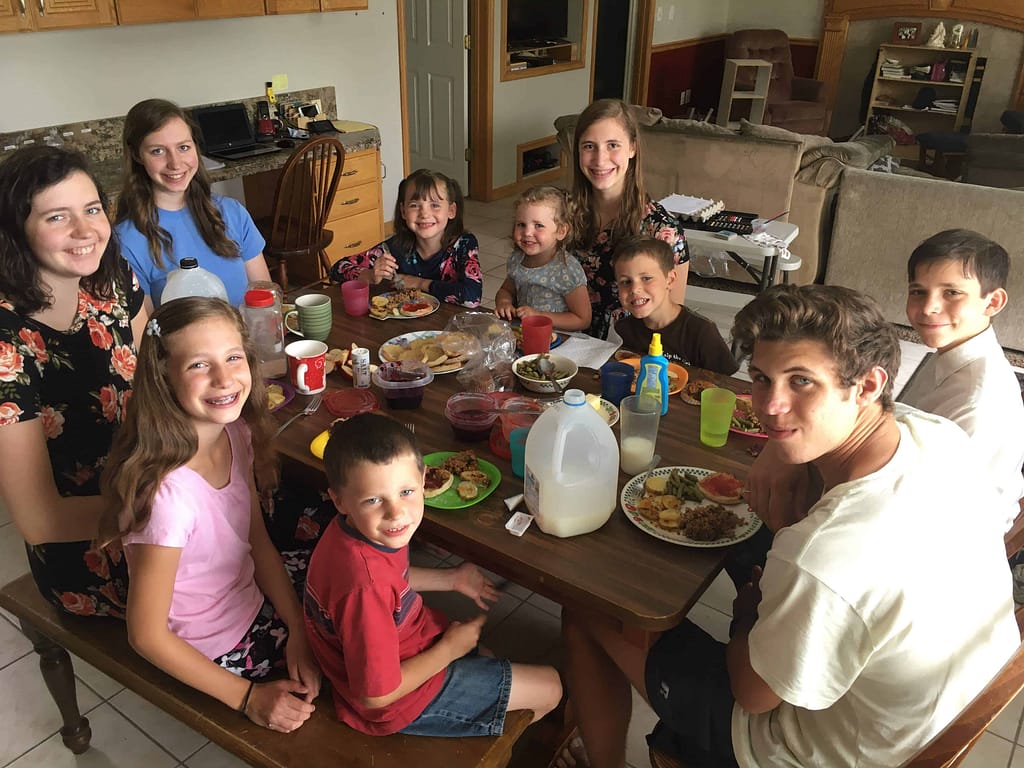
Dinner time can be crazy at our house with 10 young’uns, but keeping it fun, talking about our day, showing I value and respect each child, keeps my teens wanting to come home for dinner. They don’t want to miss the laughter, tasty nutritious food and the love that fills their bodies and souls.

The 5 little kids planting lettuce seeds in our garden. The years we rented a house and didn’t have a garden we helped an elderly neighbor tend his garden. It was so good for the kids. And we got lots of produce as a result.
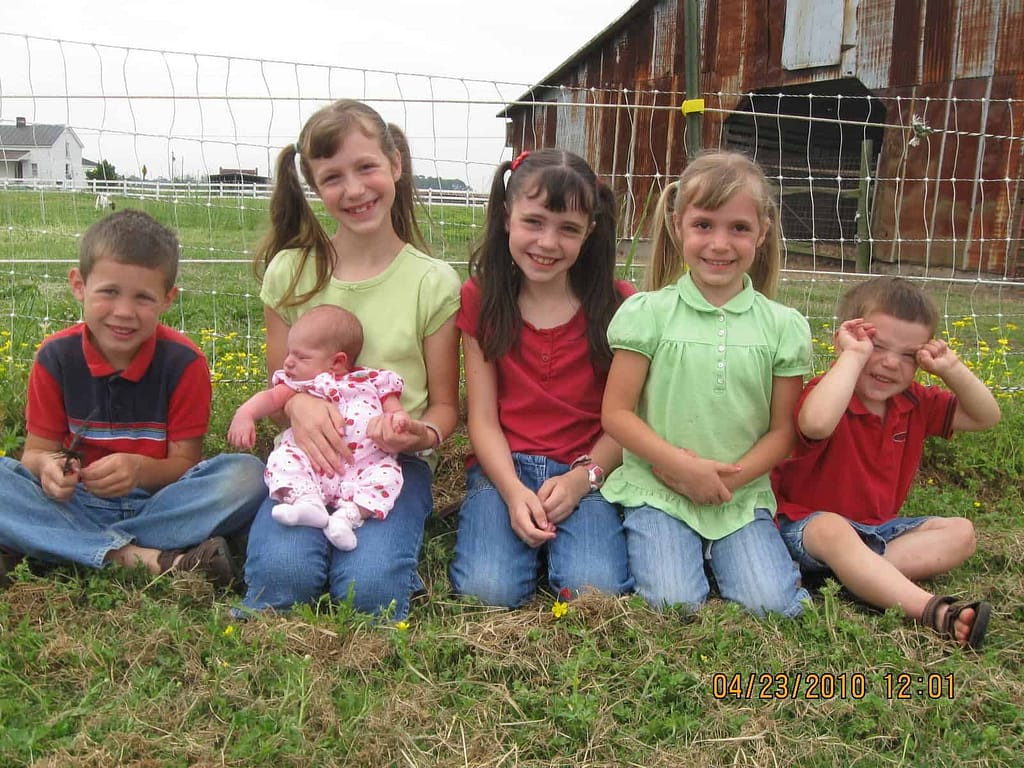
My 6 oldest kids at a strawberry patch. We made it an annual tradition. I loved taking them and experiencing a little bit of farm life years before I got my own farm. We made a lot of memories at the strawberry patch.
Pictures of their plates that the children took. They’re always so happy to have colorful plates and textures. Since we talk about it, they have learned to look for it too and be excited when we do have a pretty plate.
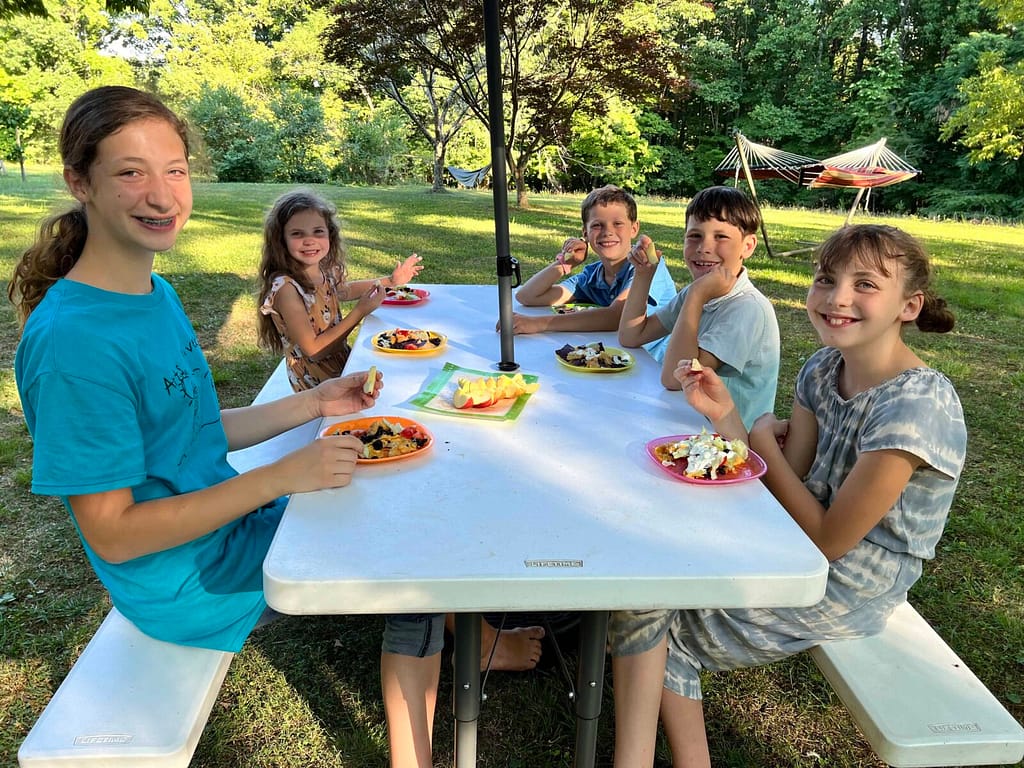
Eating outside always brings smiles to our faces.
